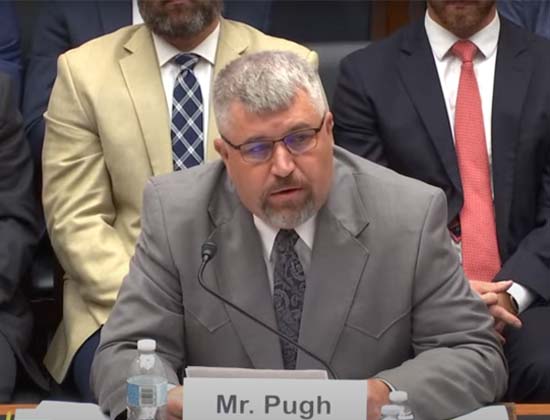To enhance highway safety, the government needs a fresh strategy for regulating the trucking sector.
This was the message conveyed by OOIDA Executive Vice President Lewie Pugh during a House Highways and Transit Subcommittee hearing on July 24.
The hearing focused on the regulatory and administrative plans of the U.S. Department of Transportation, with Pugh representing the trucking industry.
‘Ineffective Regulatory Framework’
Pugh emphasized that truck drivers are operating under an “ineffective regulatory framework” that prioritizes compliance and technology over feasible solutions that might enhance the profession and boost safety.
“Although compliance rates with a myriad of regulations have reached record highs, some, including large motor carriers, shippers, safety advocates, elected officials, and bureaucrats, not only resist the modernization or removal of unnecessary regulations but actually aim to impose even more impractical and ineffective regulations on American truckers,” Pugh stated.
Proposed regulations in recent years have included speed-limiting devices for commercial vehicles, side underride guards, and a nearly 500% increase in minimum liability insurance for trucks.
Demand for Relevant Regulations
The Owner-Operator Independent Drivers Association asserts that these proposals are driving safe and skilled truckers out of the industry, subsequently diminishing safety and disrupting America’s supply chain.
“Ultimately, truckers seek regulations that align with their needs and the evolving dynamics of their industry,” Pugh remarked. “It’s essential for Congress and the DOT to engage with the individuals making their livelihood behind the wheel to foster a thriving, safe, and sustainable trucking career.”
Recommendations for Change
Rather than enforcing more unreliable technology and complicating the trucking business landscape, Pugh advocated for the enhancement of entry-level driver training standards, increased broker transparency, and the abolition of the longstanding overtime exemption for motor carriers.
“Let me clarify; OOIDA and our members are not against regulation, as some might suggest,” Pugh noted. “In actuality, we have consistently supported regulations that address crucial needs in our industry, grounded in solid research and data. For years, we have advocated for improved driver training to ensure those operating commercial vehicles are ready to do so safely.”
Discussion on Speed Limiters
While the hearing covered a wide range of issues related to trucking and transportation, a significant portion of the discussion revolved around the Federal Motor Carrier Safety Administration’s plan to implement speed limiters on trucks.
In 2022, FMCSA released an advance notice of proposed rulemaking regarding mandatory speed limiters for commercial vehicles, with a formal proposal expected in May 2025. Safety advocates have been pushing to cap heavy-duty trucks at a top speed of 60 mph.
Concerns About Speed Differential
OOIDA argues that this requirement could endanger safety by creating risky speed differences between trucks and cars, resulting in a higher likelihood of crashes. Many highways in the U.S. have speed limits as high as 85 mph, which means cars could exceed trucks’ speeds by up to 30 mph on the same road.
“Research over the decades indicates that greater speed differentials increase interactions, like passing or braking, between truck drivers and other drivers,” Pugh wrote in his testimony. “Studies consistently show that these increased interactions heighten the chances of accidents.”
Debate Over Speed Regulations
Rep. Troy Nehls, R-Texas, concurred that imposing such slow speed limits on trucks could lead to unfavorable outcomes. “I want to remind my colleagues that DOT is contemplating limiting every truck on the road to 60 mph, regardless of the posted speed limits,” Nehls added.
Conversely, Rep. Seth Moulton, D-Mass., countered the concerns over speed limiter mandates by referring to data indicating that 20% of truck accidents occurred at speeds exceeding 70 mph, leading to around 1,000 fatalities. However, it’s worth noting that FMCSA’s earlier statistics about speed limits did not specify the actual speeds of trucks involved in crashes or whether they were using speed limiters.
Pugh concluded by suggesting that if speeding is a significant concern, the focus should instead be on reducing the speed of both cars and trucks. “It has been established repeatedly that traffic traveling at uniform speeds is the safest,” he stated.


